Multi-Particle-Collision Simulation of Heat Transfer in Low-Dimensional Fluids
Abstract
1. Introduction
2. Mesoscopic Fluid and Thermal Walls
- In the 1D case, the velocity of the ith particle in the jth cell is changed according to the update rulewhere is randomly sampled by a thermal distribution at the cell kinetic temperature , while and are cell-dependent parameters, determined by the condition of total momentum and total energy conservation in the cell [21].
- In the 2D case, all particles found in the same cell are rotated around the z axis, with respect to their center of mass velocity by two angles, or , randomly chosen with equal probability. The velocity of the ith particle in a cell is thus updated aswhere are the rotation operators by the angle .
- In the 3D case, the velocity of the ith particle in a cell is updated as in 2D case, with the difference that the rotation axis is also randomly selected.
3. One-Dimensional Fluid
3.1. Non-Equilibrium Results
3.2. Equilibrium Results
4. Two-Dimensional Fluid
4.1. Non-Equilibrium Results
4.2. Equilibrium Results
5. Three-Dimensional Fluid
5.1. Non-Equilibrium Results
5.2. Equilibrium Results
6. Dimensional Crossovers
7. Heat Transfer with Magnetic Field
8. Conclusions
Author Contributions
Funding
Data Availability Statement
Acknowledgments
Conflicts of Interest
References
- Malevanets, A.; Kapral, R. Mesoscopic model for solvent dynamics. J. Chem. Phys. 1999, 110, 8605–8613. [Google Scholar] [CrossRef]
- Kapral, R. Multiparticle Collision Dynamics: Simulation of Complex Systems on Mesoscales. In Advances in Chemical Physics; John Wiley and Sons, Ltd.: Hoboken, NJ, USA, 2008; pp. 89–146. [Google Scholar] [CrossRef]
- Gompper, G.; Ihle, T.; Kroll, D.M.; Winkler, R.G. Multi-Particle Collision Dynamics: A Particle-Based Mesoscale Simulation Approach to the Hydrodynamics of Complex Fluids. In Advanced Computer Simulation Approaches for Soft Matter Sciences III; Holm, C., Kremer, K., Eds.; Springer: Berlin/Heidelberg, Germany, 2009; pp. 1–87. [Google Scholar] [CrossRef]
- Di Cintio, P.; Pasquato, M.; Kim, H.; Yoon, S.-J. Introducing a new multi-particle collision method for the evolution of dense stellar systems–Crash-test N-body simulations. Astron. Astrophys. 2021, 649, A24. [Google Scholar] [CrossRef]
- Belushkin, M.; Livi, R.; Foffi, G. Hydrodynamics and the Fluctuation Theorem. Phys. Rev. Lett. 2011, 106, 210601. [Google Scholar] [CrossRef]
- Benenti, G.; Casati, G.; Mejía-Monasterio, C. Thermoelectric efficiency in momentum-conserving systems. New J. Phys. 2014, 16, 015014. [Google Scholar] [CrossRef]
- Gao, Y.; Chen, Z.; Zhang, Y.; Wen, Y.; Yu, X.; Shan, B.; Xu, B.; Chen, R. Reorientation of Hydrogen Bonds Renders Unusual Enhancement in Thermal Transport of Water in Nanoconfined Environments. Nano Lett. 2024, 24, 5379–5386. [Google Scholar] [CrossRef] [PubMed]
- Eapen, J.; Li, J.; Yip, S. Mechanism of Thermal Transport in Dilute Nanocolloids. Phys. Rev. Lett. 2007, 98, 028302. [Google Scholar] [CrossRef]
- Sarkar, S.; Selvam, R.P. Molecular dynamics simulation of effective thermal conductivity and study of enhanced thermal transport mechanism in nanofluids. J. Appl. Phys. 2007, 102, 074302. [Google Scholar] [CrossRef]
- Cheng, H.; Ouyang, J. Soret Effect of Ionic Liquid Gels for Thermoelectric Conversion. J. Phys. Chem. Lett. 2022, 13, 10830–10842. [Google Scholar] [CrossRef] [PubMed]
- Lepri, S.; Livi, R.; Politi, A. Thermal conduction in classical low-dimensional lattices. Phys. Rep. 2003, 377, 1–80. [Google Scholar] [CrossRef]
- Dhar, A. Heat transport in low-dimensional systems. Adv. Phys. 2008, 57, 457–537. [Google Scholar] [CrossRef]
- Benenti, G.; Lepri, S.; Livi, R. Anomalous Heat Transport in Classical Many-Body Systems: Overview and Perspectives. Front. Phys. 2020, 8, 292. [Google Scholar] [CrossRef]
- Li, N.; Ren, J.; Wang, L.; Zhang, G.; Hänggi, P.; Li, B. Colloquium: Phononics: Manipulating heat flow with electronic analogs and beyond. Rev. Mod. Phys. 2012, 84, 1045–1066. [Google Scholar] [CrossRef]
- Gu, X.; Wei, Y.; Yin, X.; Li, B.; Yang, R. Colloquium: Phononic thermal properties of two-dimensional materials. Rev. Mod. Phys. 2018, 90, 041002. [Google Scholar] [CrossRef]
- Maldovan, M. Sound and heat revolutions in phononics. Nature 2013, 503, 209–217. [Google Scholar] [CrossRef] [PubMed]
- Benenti, G.; Donadio, D.; Lepri, S.; Livi, R. Non-Fourier heat transport in nanosystems. Riv. Nuovo C. 2023, 46, 105–161. [Google Scholar] [CrossRef]
- Lebowitz, J.L.; Spohn, H. Transport properties of the Lorentz gas: Fourier’s law. J. Stat. Phys. 1978, 19, 633–654. [Google Scholar] [CrossRef]
- Tehver, R.; Toigo, F.; Koplik, J.; Banavar, J.R. Thermal walls in computer simulations. Phys. Rev. E 1998, 57, R17–R20. [Google Scholar] [CrossRef]
- Padding, J.T.; Louis, A.A. Hydrodynamic interactions and Brownian forces in colloidal suspensions: Coarse-graining over time and length scales. Phys. Rev. E 2006, 74, 031402. [Google Scholar] [CrossRef]
- Di Cintio, P.; Livi, R.; Bufferand, H.; Ciraolo, G.; Lepri, S.; Straka, M.J. Anomalous dynamical scaling in anharmonic chains and plasma models with multiparticle collisions. Phys. Rev. E 2015, 92, 062108. [Google Scholar] [CrossRef]
- Li, B.; Casati, G.; Wang, J. Heat conductivity in linear mixing systems. Phys. Rev. E 2003, 67, 021204. [Google Scholar] [CrossRef]
- Chen, S.; Wang, J.; Casati, G.; Benenti, G. Nonintegrability and the Fourier heat conduction law. Phys. Rev. E 2014, 90, 032134. [Google Scholar] [CrossRef] [PubMed]
- Luo, R. Heat conduction in two-dimensional momentum-conserving and -nonconserving gases. Phys. Rev. E 2020, 102, 052104. [Google Scholar] [CrossRef] [PubMed]
- Luo, R.; Huang, L.; Lepri, S. Heat conduction in a three-dimensional momentum-conserving fluid. Phys. Rev. E 2021, 103, L050102. [Google Scholar] [CrossRef]
- Dhar, A. Heat Conduction in a One-Dimensional Gas of Elastically Colliding Particles of Unequal Masses. Phys. Rev. Lett. 2001, 86, 3554–3557. [Google Scholar] [CrossRef]
- Lepri, S.; Politi, A. Density profiles in open superdiffusive systems. Phys. Rev. E 2011, 83, 030107. [Google Scholar] [CrossRef]
- Kundu, A.; Bernardin, C.; Saito, K.; Kundu, A.; Dhar, A. Fractional equation description of an open anomalous heat conduction set-up. J. Stat. Mech. Theory Exp. 2019, 2019, 013205. [Google Scholar] [CrossRef]
- Lippi, A.; Livi, R. Heat Conduction in Two-Dimensional Nonlinear Lattices. J. Stat. Phys. 2000, 100, 1147–1172. [Google Scholar] [CrossRef]
- Mai, T.; Dhar, A.; Narayan, O. Equilibration and Universal Heat Conduction in Fermi-Pasta-Ulam Chains. Phys. Rev. Lett. 2007, 98, 184301. [Google Scholar] [CrossRef]
- Kubo, R.; Toda, M.; Hashitsume, N. Statistical Physics II: Nonequilibrium Statistical Mechanics; Springer: New York, NY, USA, 1991. [Google Scholar]
- Casati, G.; Prosen, T.C.V. Anomalous heat conduction in a one-dimensional ideal gas. Phys. Rev. E 2003, 67, 015203. [Google Scholar] [CrossRef]
- Zhao, H. Identifying Diffusion Processes in One-Dimensional Lattices in Thermal Equilibrium. Phys. Rev. Lett. 2006, 96, 140602. [Google Scholar] [CrossRef]
- Levashov, V.A.; Morris, J.R.; Egami, T. Viscosity, Shear Waves, and Atomic-Level Stress-Stress Correlations. Phys. Rev. Lett. 2011, 106, 115703. [Google Scholar] [CrossRef] [PubMed]
- Chen, S.; Zhang, Y.; Wang, J.; Zhao, H. Finite-size effects on current correlation functions. Phys. Rev. E 2014, 89, 022111. [Google Scholar] [CrossRef] [PubMed]
- Prosen, T.; Campbell, D.K. Normal and anomalous heat transport in one-dimensional classical lattices. Chaos 2005, 15, 978. [Google Scholar] [CrossRef]
- Ihle, T.; Kroll, D.M. Stochastic rotation dynamics: A Galilean-invariant mesoscopic model for fluid flow. Phys. Rev. E 2001, 63, 020201. [Google Scholar] [CrossRef]
- Narayan, O.; Ramaswamy, S. Anomalous Heat Conduction in One-Dimensional Momentum-Conserving Systems. Phys. Rev. Lett. 2002, 89, 200601. [Google Scholar] [CrossRef]
- Zhao, H.; Wang, W.G. Fourier heat conduction as a strong kinetic effect in one-dimensional hard-core gases. Phys. Rev. E 2018, 97, 010103. [Google Scholar] [CrossRef]
- Miron, A.; Cividini, J.; Kundu, A.; Mukamel, D. Derivation of fluctuating hydrodynamics and crossover from diffusive to anomalous transport in a hard-particle gas. Phys. Rev. E 2019, 99, 012124. [Google Scholar] [CrossRef]
- Lepri, S.; Livi, R.; Politi, A. Too Close to Integrable: Crossover from Normal to Anomalous Heat Diffusion. Phys. Rev. Lett. 2020, 125, 040604. [Google Scholar] [CrossRef]
- Zhao, H.; Zhao, H. Testing the Stokes-Einstein relation with the hard-sphere fluid model. Phys. Rev. E 2021, 103, L030103. [Google Scholar] [CrossRef]
- Lepri, S.; Ciraolo, G.; Di Cintio, P.; Gunn, J.; Livi, R. Kinetic and hydrodynamic regimes in multi-particle-collision dynamics of a one-dimensional fluid with thermal walls. Phys. Rev. Res. 2021, 3, 013207. [Google Scholar] [CrossRef]
- Fu, W.; Wang, Z.; Wang, Y.; Zhang, Y.; Zhao, H. Nonintegrability-driven Transition from Kinetics to Hydrodynamics. arXiv 2023, arXiv:2310.12295. [Google Scholar]
- van Beijeren, H. Exact Results for Anomalous Transport in One-Dimensional Hamiltonian Systems. Phys. Rev. Lett. 2012, 108, 180601. [Google Scholar] [CrossRef] [PubMed]
- Spohn, H. Nonlinear Fluctuating Hydrodynamics for Anharmonic Chains. J. Stat. Phys. 2014, 154, 1191–1227. [Google Scholar] [CrossRef]
- Basile, G.; Bernardin, C.; Olla, S. Momentum Conserving Model with Anomalous Thermal Conductivity in Low Dimensional Systems. Phys. Rev. Lett. 2006, 96, 204303. [Google Scholar] [CrossRef]
- Xu, X.; Pereira, L.F.C.; Wang, Y.; Wu, J.; Zhang, K.; Zhao, X.; Bae, S.; Bui, C.T.; Xie, R.; Thong, J.T.L.; et al. Length-dependent thermal conductivity in suspended single-layer graphene. Nat. Commun. 2014, 5, 3689. [Google Scholar] [CrossRef]
- Tamaki, S.; Sasada, M.; Saito, K. Heat Transport via Low-Dimensional Systems with Broken Time-Reversal Symmetry. Phys. Rev. Lett. 2017, 119, 110602. [Google Scholar] [CrossRef]
- Keiji, S.; Makiko, S. Thermal Conductivity for Coupled Charged Harmonic Oscillators with Noise in a Magnetic Field. Commun. Math. Phys. 2018, 361, 1–45. [Google Scholar]
- Tamaki, S.; Saito, K. Nernst-like effect in a flexible chain. Phys. Rev. E 2018, 98, 052134. [Google Scholar] [CrossRef]
- Bhat, J.M.; Cane, G.; Bernardin, C.; Dhar, A. Heat Transport in an Ordered Harmonic Chain in Presence of a Uniform Magnetic Field. J. Stat. Phys. 2022, 186, 1–15. [Google Scholar] [CrossRef]
- Johnson, B.R.; Hirschfelder, J.O.; Yang, K.H. Interaction of atoms, molecules, and ions with constant electric and magnetic fields. Rev. Mod. Phys. 1983, 55, 109–153. [Google Scholar] [CrossRef]
- Luo, R.; Zhang, Q.; Lin, G.; Lepri, S. Heat conduction in low-dimensional electron gases without and with a magnetic field. Phys. Rev. E 2025, 111, 014116. [Google Scholar] [CrossRef] [PubMed]
- Di Cintio, P.; Livi, R.; Lepri, S.; Ciraolo, G. Multiparticle collision simulations of two-dimensional one-component plasmas: Anomalous transport and dimensional crossovers. Phys. Rev. E 2017, 95, 043203. [Google Scholar] [CrossRef]
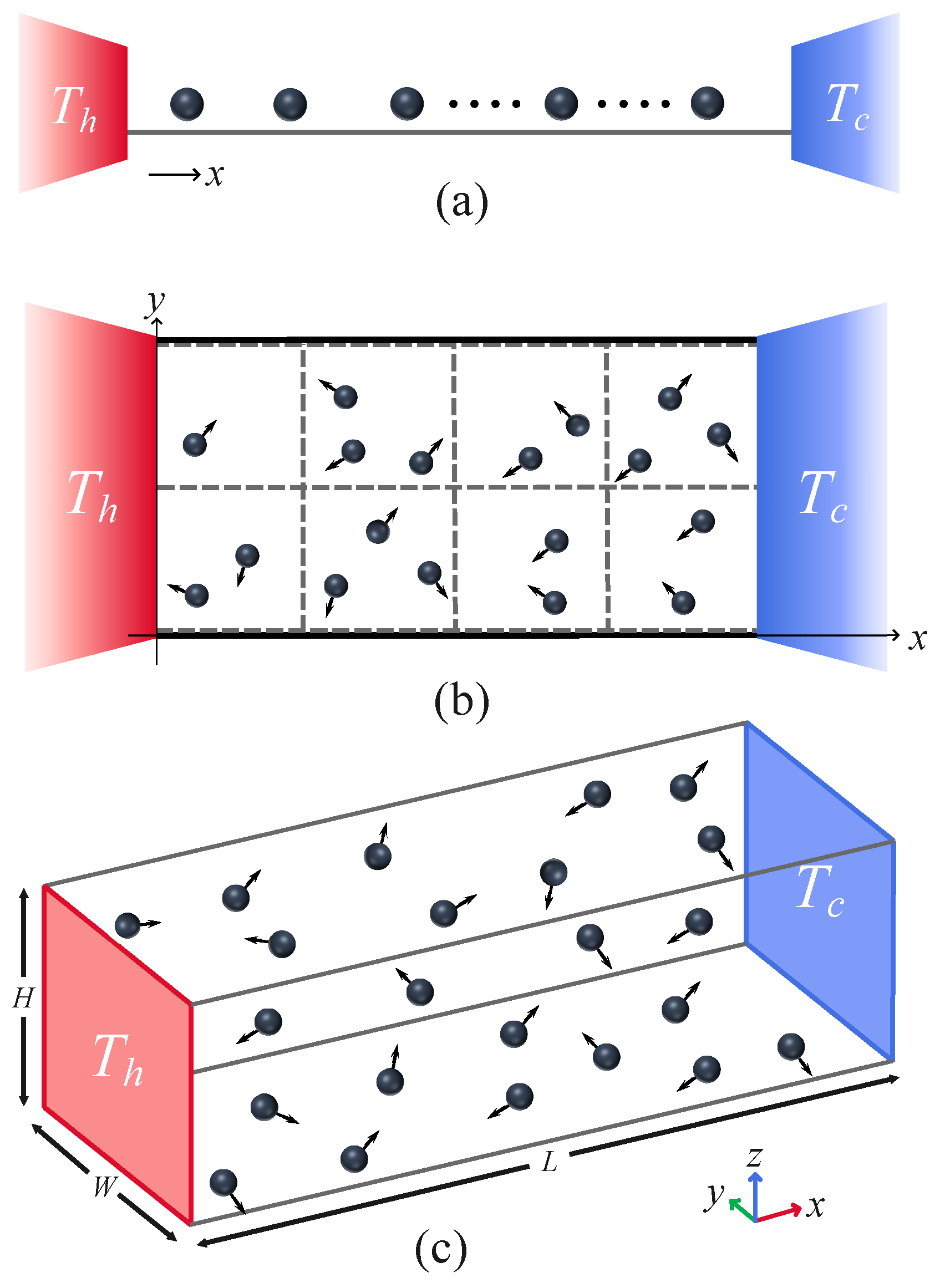
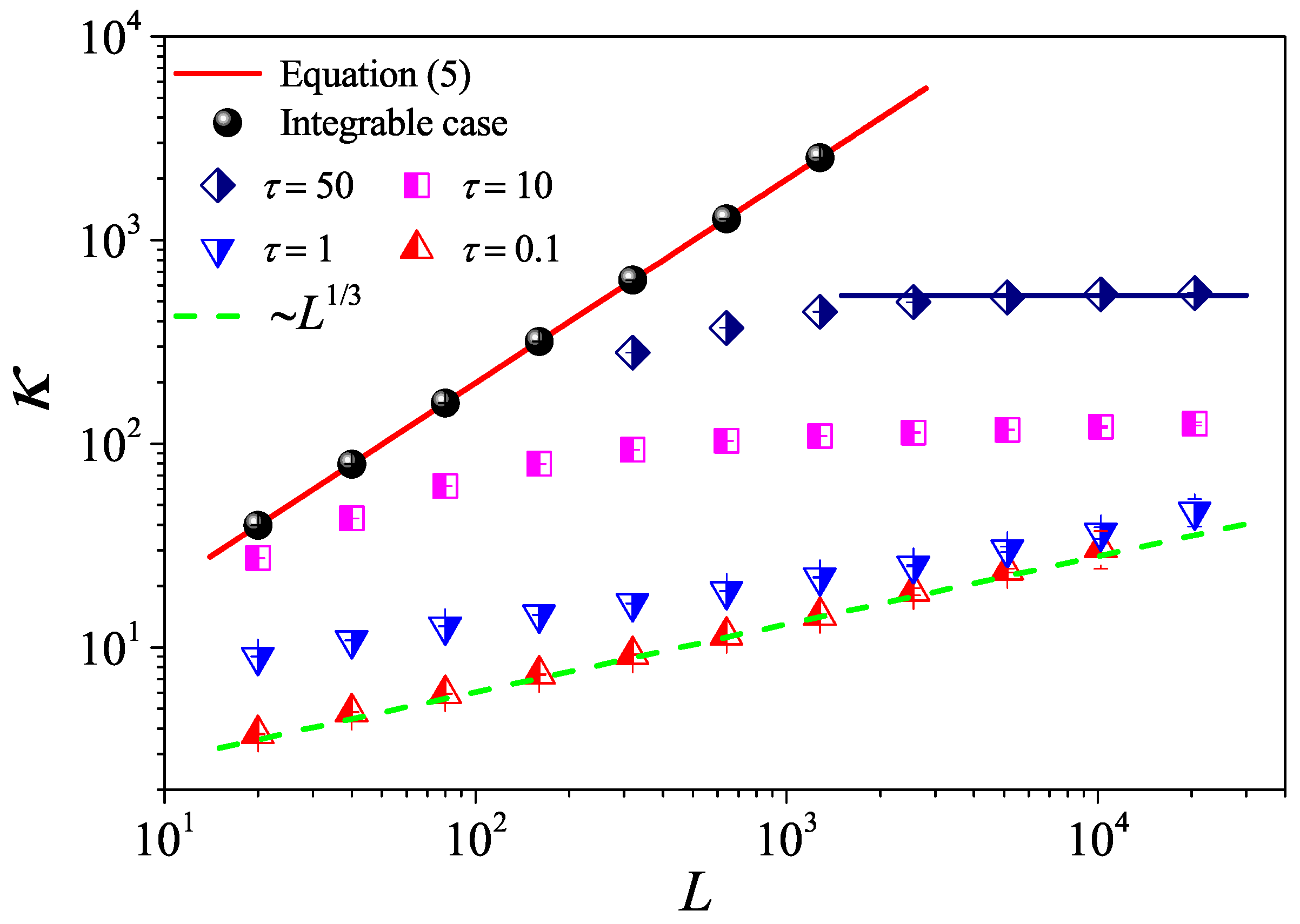




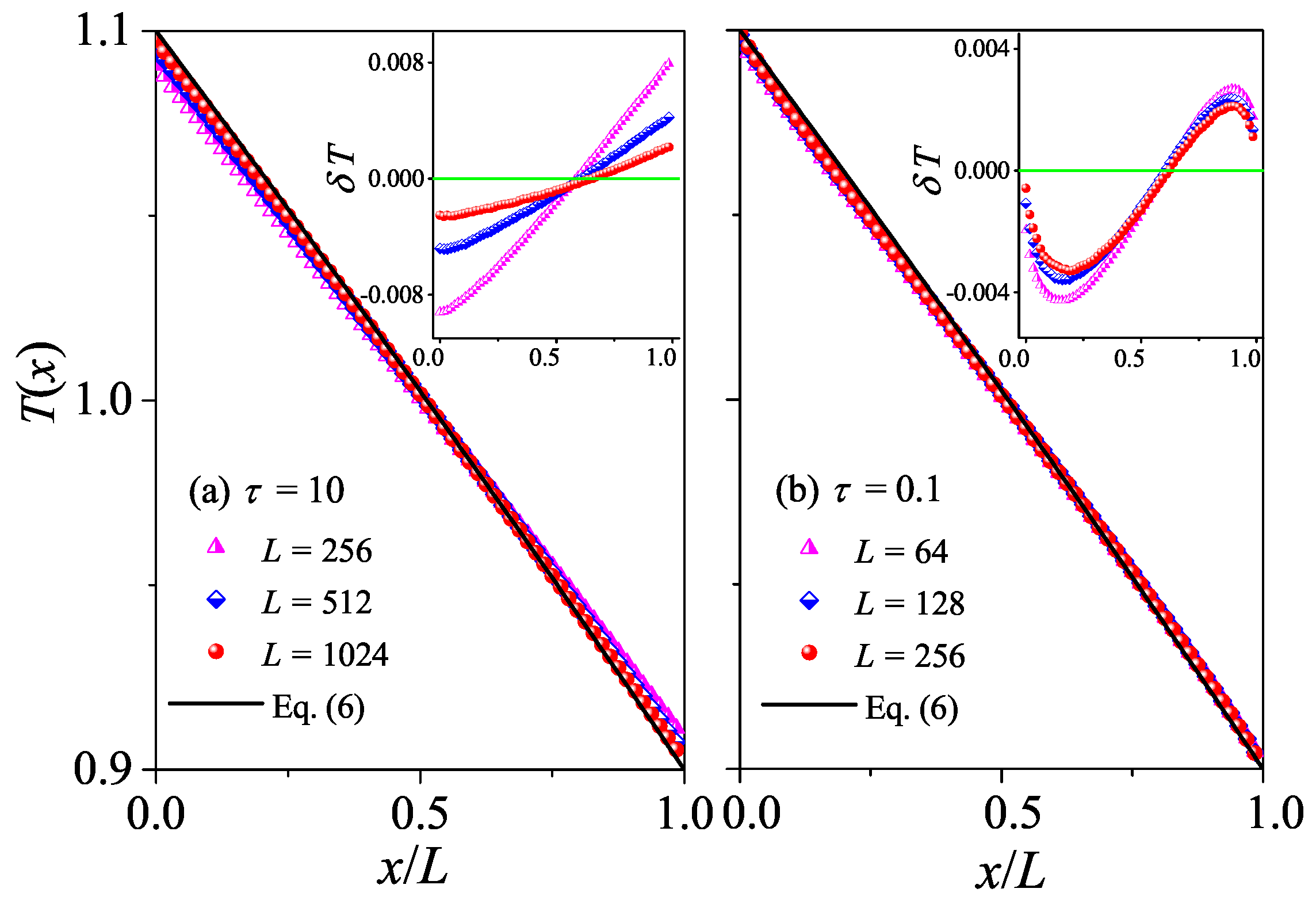
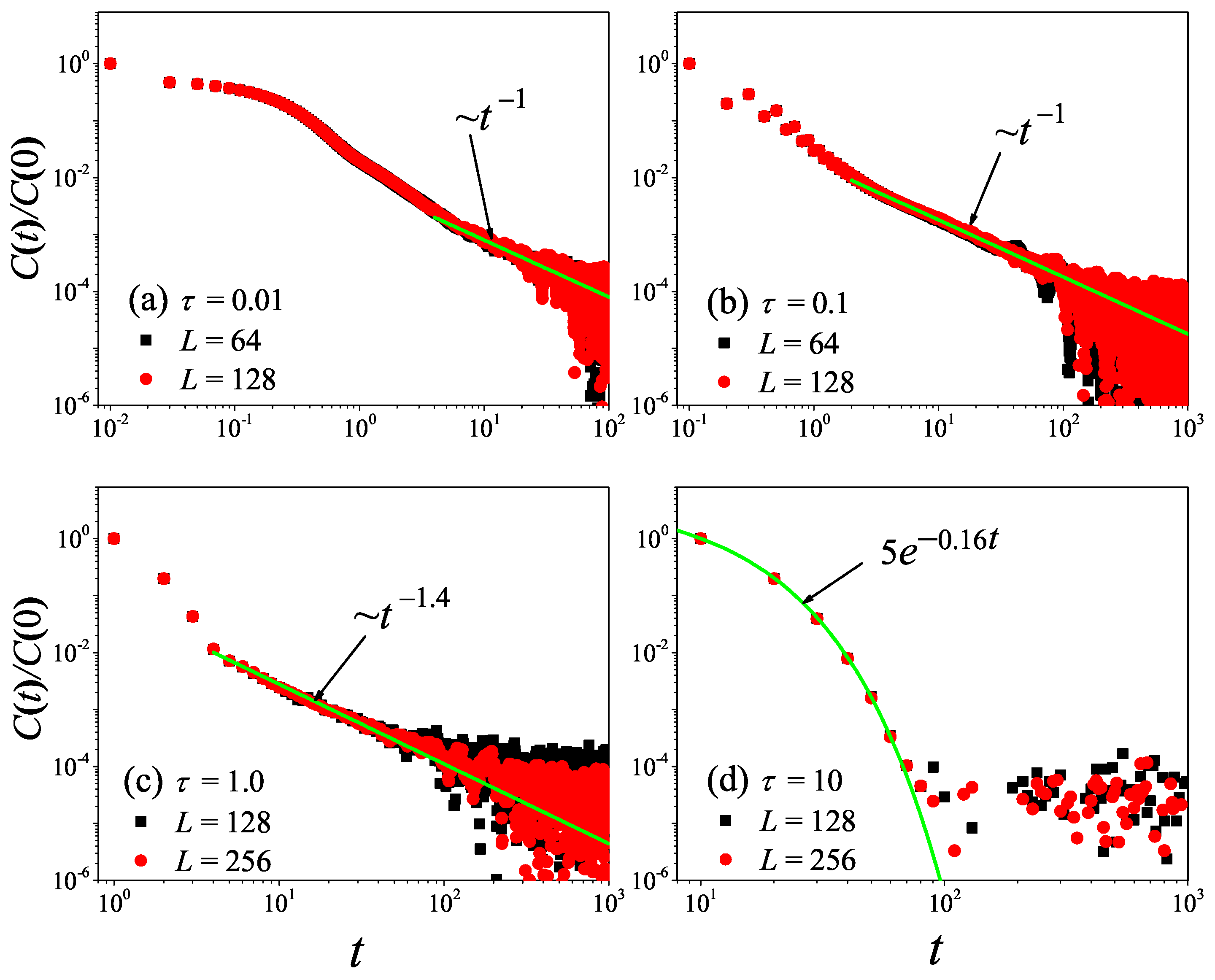
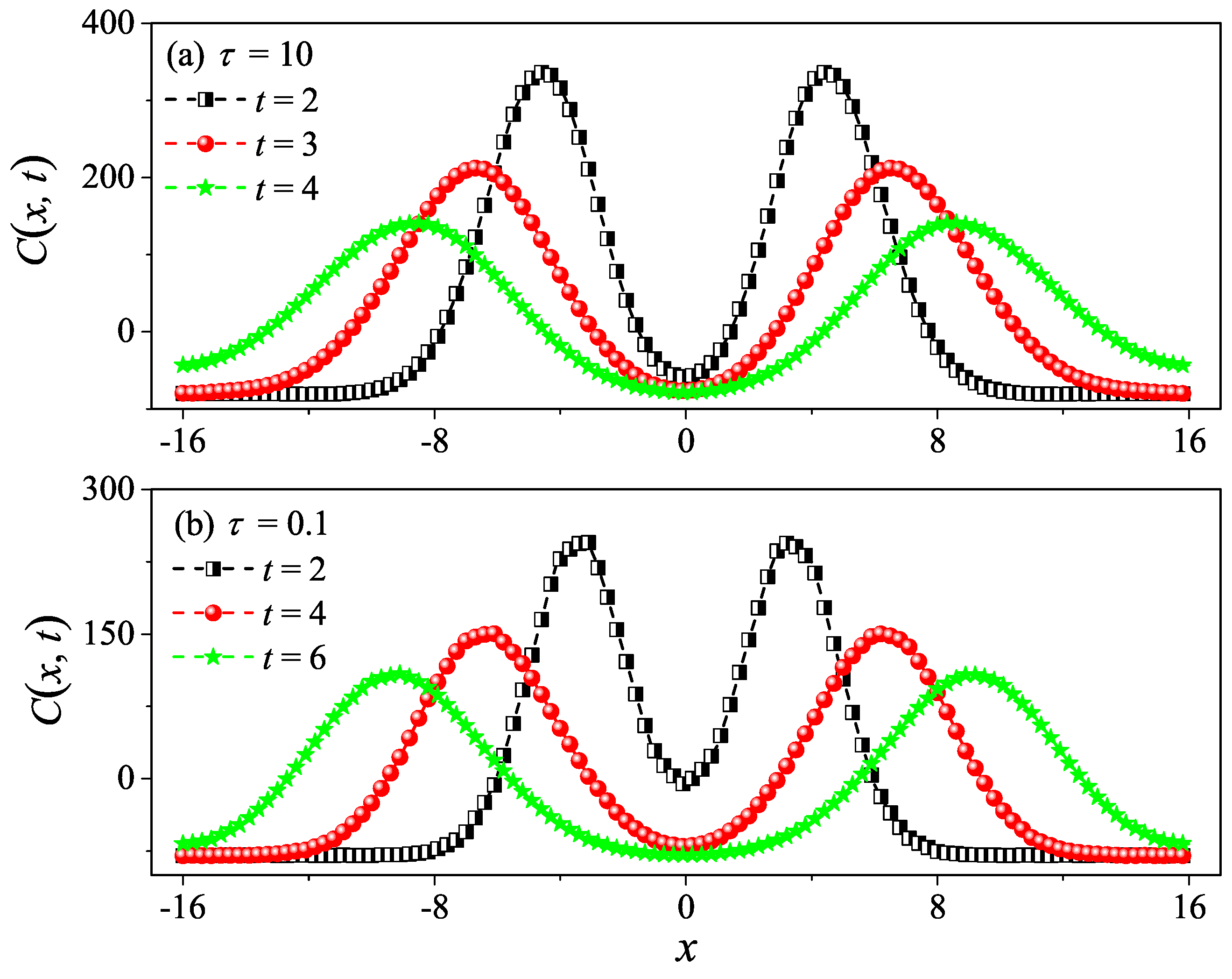

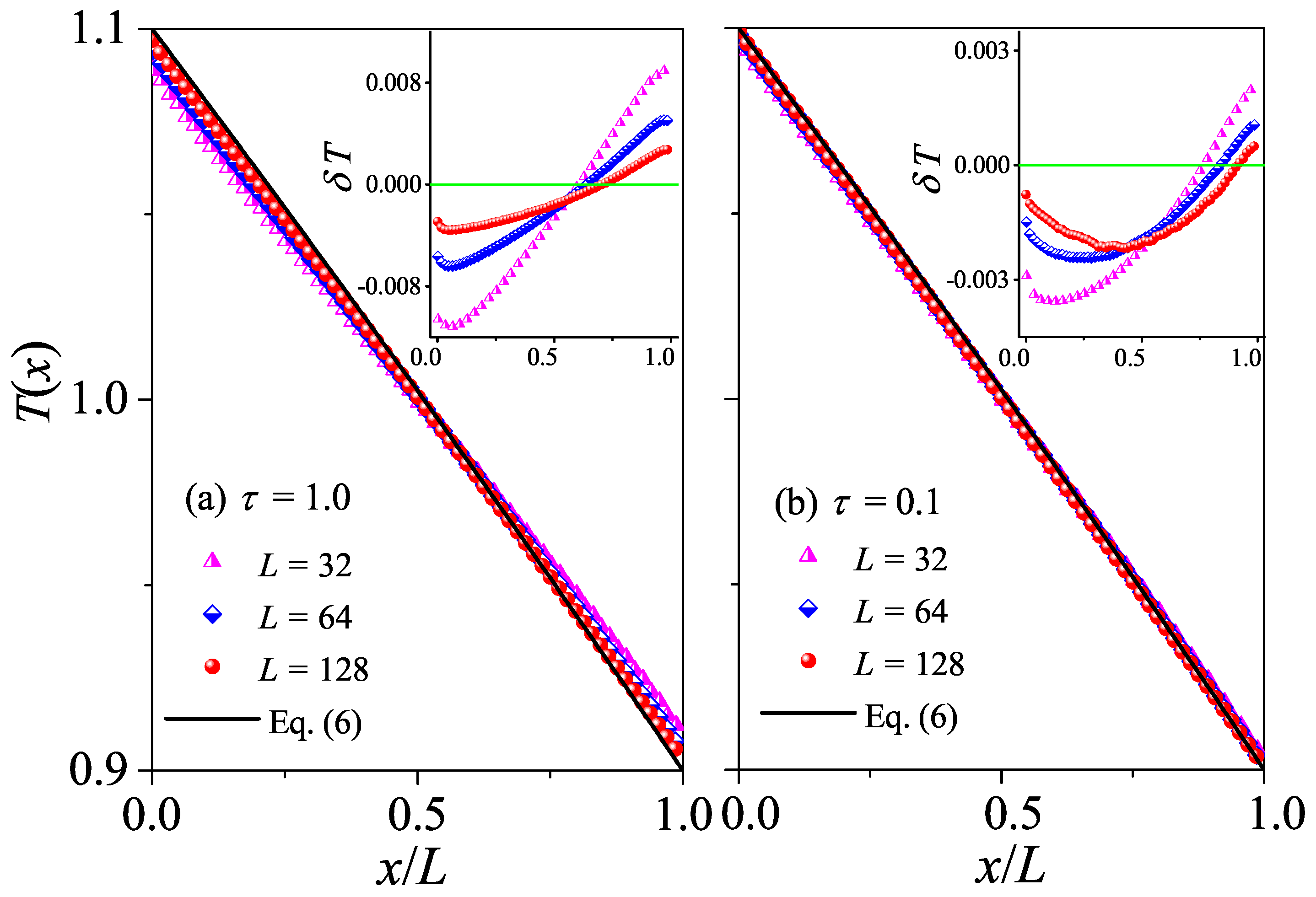


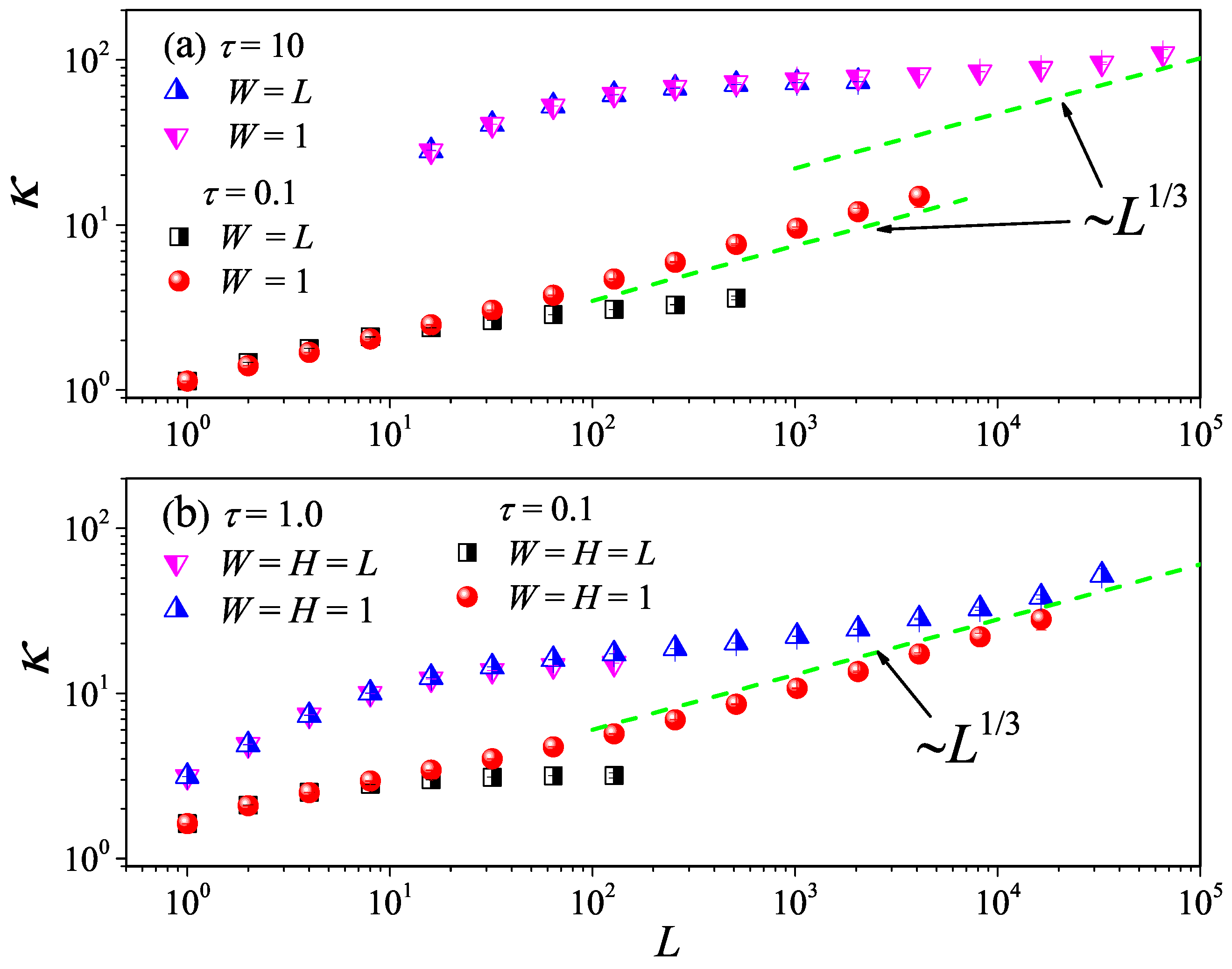

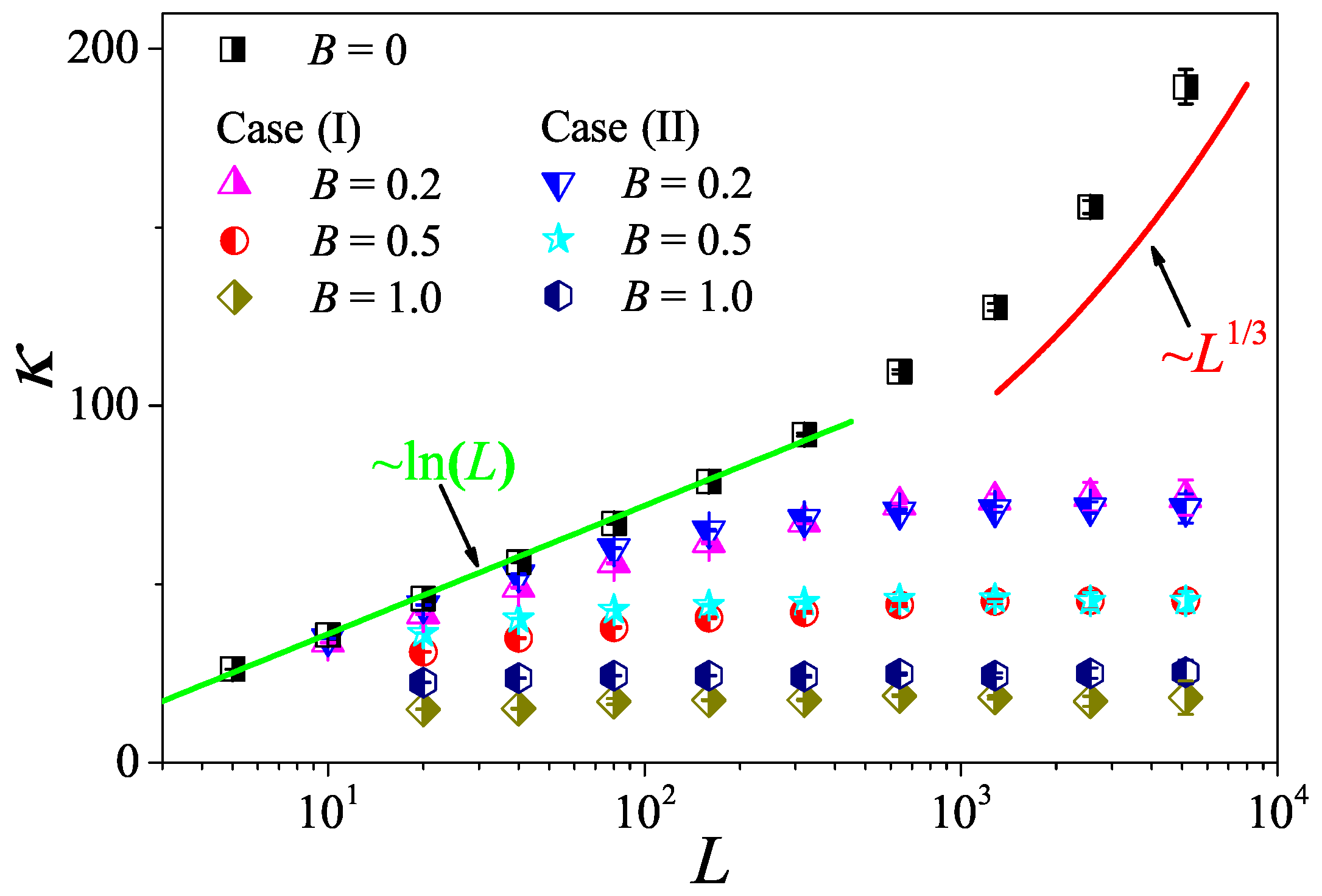
Disclaimer/Publisher’s Note: The statements, opinions and data contained in all publications are solely those of the individual author(s) and contributor(s) and not of MDPI and/or the editor(s). MDPI and/or the editor(s) disclaim responsibility for any injury to people or property resulting from any ideas, methods, instructions or products referred to in the content. |
© 2025 by the authors. Licensee MDPI, Basel, Switzerland. This article is an open access article distributed under the terms and conditions of the Creative Commons Attribution (CC BY) license (https://creativecommons.org/licenses/by/4.0/).
Share and Cite
Luo, R.; Lepri, S. Multi-Particle-Collision Simulation of Heat Transfer in Low-Dimensional Fluids. Entropy 2025, 27, 455. https://doi.org/10.3390/e27050455
Luo R, Lepri S. Multi-Particle-Collision Simulation of Heat Transfer in Low-Dimensional Fluids. Entropy. 2025; 27(5):455. https://doi.org/10.3390/e27050455
Chicago/Turabian StyleLuo, Rongxiang, and Stefano Lepri. 2025. "Multi-Particle-Collision Simulation of Heat Transfer in Low-Dimensional Fluids" Entropy 27, no. 5: 455. https://doi.org/10.3390/e27050455
APA StyleLuo, R., & Lepri, S. (2025). Multi-Particle-Collision Simulation of Heat Transfer in Low-Dimensional Fluids. Entropy, 27(5), 455. https://doi.org/10.3390/e27050455





